
Caution: Don’t judge a packaging by the materials it is made up of. You might have noticed the new-age packaging arrives with a foul smell, but we have to tolerate it as it is the only way to continue to support healthy globalisation and maintain the well-being and integrity of our planet.
In recent years, sustainable packaging has become a critical aspect of today’s world, and this has led to a growing interest in sustainable packaging. Sustainable packaging refers to the use of packaging materials and methods that are eco-friendly, recyclable, and biodegradable.
Renewable materials are those that can be replenished naturally and quickly, such as bamboo, paper, and cornstarch. These materials are biodegradable and can be composted, which reduces the amount of waste that ends up in landfills. Additionally, renewable materials are less energy-intensive to produce, which means they have a smaller carbon footprint.
Sustainable packaging seeks to minimise the environmental impact of packaging materials by reducing waste, conserving resources, and reducing greenhouse gas emissions. The need to reduce environmental degradation and protect the planet has never been greater. Let’s look at the trends, benefits, and impacts of sustainable packaging.
Trends in Sustainable Packaging

- Biodegradable Materials:
Biodegradable materials such as compostable plastics, biodegradable plastics, and plant-based materials are increasingly used in sustainable packaging. These materials include plant-based plastics, such as polylactic acid (PLA) and cellulose, and biodegradable films made from corn starch or potato starch, leaving no harmful residue behind. Biodegradable packaging is already widely used in the food industry, and its popularity is expected to grow in the coming times.
- Recyclable Materials:
Another trend in sustainable packaging is the focus on recycling. Nowadays, many companies use recycled materials to make their packaging, and many design their packaging to be easily recyclable. The packaging materials can be recycled and reused, reducing the amount of waste going into landfills. In addition, some companies are incorporating recyclable materials into their packaging, such as using recycled cardboard for boxes or glass for jars.
- Minimalist Design:
Minimalist design is a trend that focuses on reducing the amount of packaging used by keeping it as simple and minimal as possible without sacrificing functionality or aesthetics. Minimalist packaging uses fewer materials, which helps in reducing waste and lowers the environmental impact of production. The design approach in minimalist packaging considers the product’s size, shape, and weight and aims to reduce the amount of packaging needed while still protecting the product.
- Multi-Use Packaging:
Reusable packaging is a trend that is gaining popularity in the food and beverage industry. The type focuses on designing packaging that can be used for multiple purposes, which reduces the amount of waste that ends up in landfills. Reusable packaging can take many forms, from refillable water bottles to reusable food containers. Some companies are even experimenting with reusable packaging for shampoo and laundry detergent items.
- Innovative packaging materials:
Innovation is the key to survival, and when it comes to packaging, scientists and researchers are working on developing new materials that are more sustainable than traditional packaging materials. For example, some companies are exploring the use of seaweed-based materials for food packaging, while others are looking at using mushroom-based materials for packaging.
Benefits of Sustainable Packaging

- Reduced Waste: Sustainable packaging helps to reduce waste by using materials that are biodegradable, recyclable, or compostable.
- Lower Carbon Footprint: Sustainable packaging helps to lower the carbon footprint by reducing the amount of energy required to manufacture and transport packaging materials.
- Increased Brand Image: Sustainable packaging helps companies to create a positive brand image by showing their commitment to environmental protection.
- Cost Savings: Sustainable packaging can help companies save money in the long run by reducing the amount of packaging needed and lowering transportation costs.
Impact of Sustainable Packaging

- Reduced Environmental Impact: Sustainable packaging helps to reduce the environmental impact by reducing the amount of waste that goes into landfills and the amount of energy required to manufacture and transport packaging materials.
- Increased Consumer Awareness: Sustainable packaging has helped to raise consumer awareness of environmental issues and encourages them to make more sustainable choices.
- Government Regulation: Governments around the world are taking steps to regulate packaging waste, and sustainable packaging is a critical part of this effort.
- Market Growth: Sustainable packaging has opened up new market opportunities for companies that are committed to sustainability.

